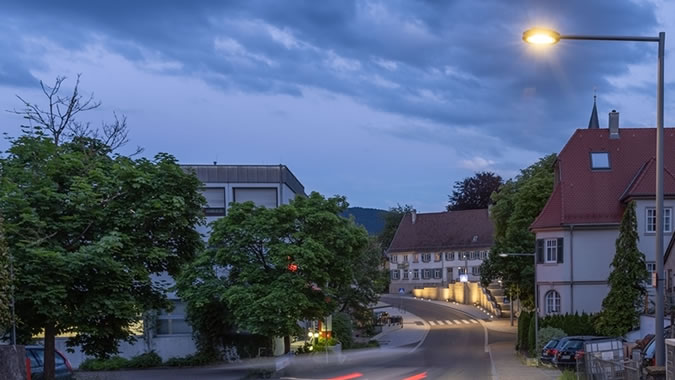
Heiningen Sustainable Lighting
Adaptive lighting solution saves energy, preserves natural eco-systems and ensures safety for citizens
The town of Heiningen, located in the south of Germany, is surrounded by the rolling hills and mountains of the Swabian Alb. The region is well known for its beautiful countryside where residents and visitors can enjoy fantastic views and spectacular hikes. The local authorities are eager to preserve this natural environment and its wildlife. They were particularly concerned with preventing insects from becoming extinct due to harsh artificial light.
Smart lighting to save energy and ensure safety
Like in a lot of small towns, there is little traffic during the night in Heiningen, especially during the week. From time to time however, the main road (L1217) acts as a diversion route when there are problems on the nearby motorway and experiences a high volume of traffic.
The local authorities wanted to install a smart lighting solution along this main road to dim the light during the hours when there is very little traffic to save energy and reduce their carbon footprint all while providing a safe throughway for citizens.
Sustainable lighting to preserve insects
In 2020, the German Federal Nature Conservation Act was amended to preserve nature and landscapes. The mortality rate of insects was increasing and the authorities are keen to stop this trend as they are an important part of the natural eco-system. This is believed to be due to certain types of artificial light – blue and ultraviolet – at night, which attract the insects, altering their behaviour as they circle the light until they become exhausted, and ultimately die.
The town of Heiningen was therefore also looking to reduce light pollution to preserve its insects and the dark skies.
Adaptive lighting with the Schréder EXEDRA control system
The local authorities of Heinigen decided to go one step further than simply dimming the light at night. They wanted to implement a pilot installation that would adapt the lighting according to the real traffic in the town and measure the impact of the reduced lighting on insects for a one-year period. Together with the Technical University of Berlin, Urban Lighting Innovations GmbH, Netze BW GmbH and Studio DL, we drew up an action plan and designed a lighting system that would enable the town council to achieve all of its objectives. Our Schréder EXEDRA control system is the technical heart of this smart city project and connects the different technologies for optimal performance.
The project is financed by funding from the Ministry of Transport of the State of Baden-Württemberg.
Aesthetic and energy-saving LED luminaires go smart
The town had already installed 49 YOA LED luminaires along its main road in 2018 to reduce its energy consumption and its carbon footprint. The YOA luminaires had cut costs by 50% and are highly appreciated for their refined design which brings an elegant touch to the landscape.
In 2022, the YOA luminaires were fitted with OWLET controllers and connected to the Schréder EXEDRA platform to dim the light at night. A thermal camera, a microphone and a Bluetooth tracker were also installed to monitor the traffic. Data from all devices and a third-party cloud service is transmitted to the Schréder EXEDRA platform which then adapts the light to real-time conditions to ensure safety when motorists are driving. When little or no traffic is detected, the light is dimmed by 75%. After one-year the local authorities will choose one of the tools to measure the traffic for the future.
The luminaires lighting pedestrian crossings are not integrated into this project to maintain the lighting levels at 100% at all times and ensure safety.
The Schréder EXEDRA platform will also enable the town to monitor the lighting network and optimise operations over time.
A nomination for the Reallabore 2022 Innovation Award
The project has attracted the interest of many other towns and cities eager to see the results. It was nominated for the Federal Ministry for Economic Affairs and Climate Protection’s “Reallabore 2022 Innovation Award” which recognises outstanding pilot projects for their contribution to a modern and sustainable environment